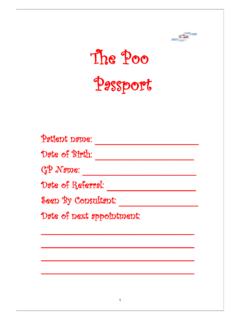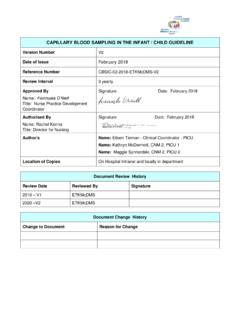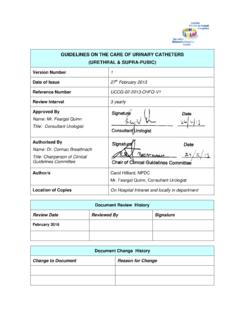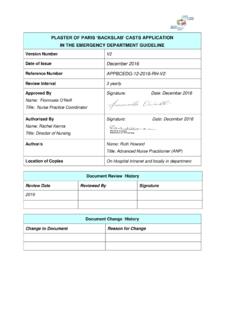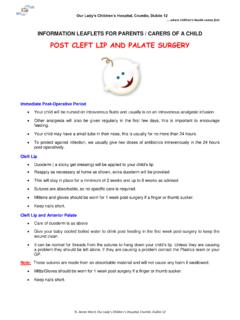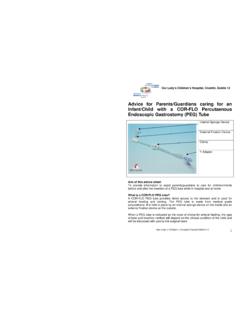Transcription of GUIDELINE FOR NURSES ON ASSISTING WITH INTUBATION …
1 GUIDELINE FOR NURSES ON ASSISTING with INTUBATION AND extubation OF INFANTS AND CHILDREN Version Number V3 Date of Issue May 2016 Reference Number NAIEIC-05-2016-ETRC-V3 Review Interval 3 yearly Approved By Name: Fionnuala O Neill Title: Nurse Practice Coordinator Signature: Date: May 2016 Authorised By Name: Rachel Kenna Title: Director of Nursing Signature: Date: May 2016 Author/s Name: Eileen Tiernan Title: Clinical Coordinator Graduate Diploma Critical Care Nursing (Children), PICUs.
2 Name: Rosemary Clerkin Title: Clinical Nurse Facilitator, Theatres Acknowledgement: Andrew Pendred, Audio-visual for images (Document reviewed by Consultant Anaesthetists, Intensivists, Pharmacist and Resuscitation Committee) Location of Copies On Hospital Intranet and locally in department Document Review History Review Date Reviewed By Signature 2019 Document Change History Change to Document Reason for Change Our Lady s Children s Hospital, Crumlin Document Name: GUIDELINE FOR NURSES ON ASSISTING with INTUBATION AND extubation OF INFANTS AND CHILDREN Reference Number: NAIEIC-05-2016-ETRC-V3 Version Number: V3 Date of Issue: May 2016 Page 2 of 33 Department of Anaesthetics and Recovery Contents Page 1.
3 INTUBATION a) Introduction b) ASSISTING with the INTUBATION of an infant / Child 3 3 8 2. Cuffed Endotracheal Tube Checking Cuff Pressure 13 3. extubation of an infant /Children a) Suspected Accidental / Unplanned extubation (UE) 14 19 3. Care of an infant / Child with a Nasopharyngeal Tube 20 5. Appendices Appendix I: Endotracheal Tubes Appendix II: Equipment for INTUBATION Appendix III: Securing a Nasal Endotracheal Tube (ETT) using the Modified Melbourne Strapping Technique 22 23 26 6. References 32 Our Lady s Children s Hospital, Crumlin Document Name: GUIDELINE FOR NURSES ON ASSISTING with INTUBATION AND extubation OF INFANTS AND CHILDREN Reference Number: NAIEIC-05-2016-ETRC-V3 Version Number: V3 Date of Issue: May 2016 Page 3 of 33 Department of Anaesthetics and Recovery 1.
4 A) INTUBATION - Introduction INTUBATION is the placement of an endotracheal tube in the trachea and is the gold standard and method of choice for establishment and maintenance of an airway (Chethan and Hughes 2008). Indications for INTUBATION / Ventilation Maintenance of patent airway / upper airway obstruction Worsening Respiratory Distress / Respiratory Failure Prolonged apnoea Inadequate ventilation Worsening hypoxia, despite oxygen therapy Elective INTUBATION , following neonatal surgery, cardiac surgery or prior to general anaesthesia Trauma facial injuries Neurological raised intracranial pressure (ICP), deteriorating Glasgow Coma Scale (GCS) < 8 with no gag reflex Inhalation Burns Resuscitation (NSCNN 2005, BCH 2012, Hazinski 2013).
5 Equipment (Appendix I) Cardiac monitor with audible QRS tone Oxygen saturation monitor Blood pressure monitoring of patient Rebreathing circuit (bag), mask (appropriate size) and oxygen source Airway appropriate size Appropriate size ETT, one smaller and larger (internal diameter measurement mm ET tube Appropriate sized laryngoscope o Straight blade (Miller) Preterm infant Size 0 Infants - Size 0-1 Small Child - Size 1 or 2 o Curved blade (Mackintosh) Child infant / Child (<12kgs) Size 1 Child (< 22kgs) Size 2 Large Child (< 30kgs) Size 3 Adolescent Size 3-4 NB: (Attach blade and check light and have spare light, blades and batteries to hand) Wall suction with yankauer Suction catheters, appropriate size Magill s forceps appropriate size Gauze and K-Y Jelly Nasogastric tube prn Elastoplast tape (cut in trouser legs x 2) and 3rd piece with eye hole slit Embroidery cotton (6 strand) Duoderm Cavilon Swabs Ventilator with appropriate settings checked by anaesthetist Stethoscope Scissors Trolley or clear surface for equipment Optional.)
6 Introducer / Stylet Artery forceps Gum elastic bougie (older child) End tidal CO2 detector SOAPME (Quick Guide) Suction (Yankeur) Oxygen and rebreathing / bag-mask circuit Airways (ETT, LMA, Guedel, NPA) Positioning and Personnel ( Shoulder roll, role allocation) Medication and Monitoring (Consider atropine for neonatal INTUBATION , Saturation pulse volume on) Equipment Ventilator working (Evans 2001, BCH 2012) Tracheal Tubes Estimating Endotracheal Tube Size and Length Size (Age years) + 4 4 Length (cms) Oral Tube (Age years) +12 2 Nasal Tube (Age years) +15 2 * Formulas are appropriate for children > 1 year.
7 * Preterm Infants ETT * infant < 6 months ETT * infant 6-12 months ETT (APLS 2011) Microcuff Endotracheal Tubes - Recommended Sizes Tube Size (mm) Age Newborn (3kgs) < 8 months 8 months - < 2 years 2 - < 4 years 4 - < 6 years 6 - < 8 years 8 - < 10 years 10 - < 12 years 12 - < 12 years Our Lady s Children s Hospital, Crumlin Document Name: GUIDELINE FOR NURSES ON ASSISTING with INTUBATION AND extubation OF INFANTS AND CHILDREN Reference Number: NAIEIC-05-2016-ETRC-V3 Version Number: V3 Date of Issue: May 2016 Page 5 of 33 Department of Anaesthetics and Recovery 14 - < 16 years (KimberlyClark 2006a) Tube Insertion Depth (cms) for Preterm Infants (Infants Wt (Kgs) + 6) < 1kg 6-5 7cms 1-2kgs 7-8cms 2-3kgs 8-9cms 3-4kgs >9cms (Kattwinkel et al.)
8 2000) INTUBATION Equipment (Appendix I and II) Endotracheal Tubes (Cuffed or Uncuffed Tubes) All endotracheal tubes have a preformed curve which conforms to the child s anatomy of the airway, aiding insertion and preventing kinking whilst in situ. The tube is oval in cross section but the distal end is cut at an oblique angle (bevelled) so that the aperture opens on the left side. This facilitates visualisation of the tip of tube as it passes through the cords when introduced with the right hand by the anaesthetist. There is a hole at the bevelled end (Murphy s eye) which allows an alternative route for gas flow should the bevelled end become obstructed by blood, mucus or the tracheal wall.
9 It is also believed that it allows ventilation to the other lung should inadvertent main stem INTUBATION occur. Tubes have markings from top to bottom in cms and a radio-opague longitudinal line. Sizes are in millimeters (mms) of internal diameter. Uncuffed endotracheal tubes have traditionally been used in infants / children < 8 years because their airway is funnel shaped and narrowest at the cricord cartilage which acts as a physiological seal compared to a cylinder airway in the older child / adult. However there is evidence showing that using a cuffed tube on all age groups has no increased adverse effects and also reduces multiple intubations and reduces cost (Crankshaw et al.)
10 2014). Endotracheal Tubes (Mallinckrodt) Made from siliconized PVC, with black line (radioopague) and come with standardised 15mm ISO connector. Cuffed tubes have high volume, low pressure (HVLP) Soft-Seal Profile . A spring loaded one way valve helps ensure the integrity of cuff inflation. Microcuff Tubes Microcuff paediatric endotracheal tubes (ETT) have been designed to be anatomically correct for the paediatric airway and have a thinner more distensible cuffed tube. The short cylindrical ultra-thin (10 micron) walled polyurethane, puncture resistant HVLP cuff is placed in the lower trachea, to allow Our Lady s Children s Hospital, Crumlin Document Name: GUIDELINE FOR NURSES ON ASSISTING with INTUBATION AND extubation OF INFANTS AND CHILDREN Reference Number: NAIEIC-05-2016-ETRC-V3 Version Number: V3 Date of Issue: May 2016 Page 6 of 33 Department of Anaesthetics and Recovery expansion of cuff for tracheal sealing instead of cricoid sealing.
